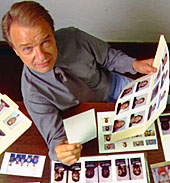AMES, Iowa -- Gary Wells, a Distinguished Professor of psychology at Iowa State University, will be featured on the CBS News show "60 Minutes" this Sunday, March 8, in a package on eyewitness misidentification in criminal cases. Credited with developing the dominant theory of how mistaken identifications occur, Wells was interviewed for the show last month in New York by correspondent Lesley Stahl.
The show can be seen locally on Des Moines' KCCI-TV (Channel 8) beginning at 6 p.m. CST.
Wells and ISU psychology graduate student Deah Quinlivan published a paper related to the "60 Minutes" topic in the February Law and Human Behavior, the journal of the American Psychology-Law Society. In their paper "Suggestive Eyewitness Identification Procedures and the Supreme Court's Reliability Test in Light of Eyewitness Science: 30 Years Later," the authors contend that it's time for the U.S. Supreme Court to revisit its landmark case (Manson v. Brathwaite, 1977) that permits eyewitness identifications obtained through suggestive law enforcement procedures.
But Wells and his fellow researchers have found that eyewitness identifications are not always reliable.
"Of the 224 people in the United States who have been found to be wrongfully convicted by juries of committing a crime (through new DNA evidence), about 77 percent -- or 172 of them -- were cases of mistaken eyewitness identification," Wells said. "So it turns out that mistaken eyewitness identification accounts now for more convictions of innocent people than all other causes combined. Now that's been a surprise, I think, to the legal system. It has not been a surprise for psychologists because we've been doing work well before forensic DNA testing came along to prove these cases on eyewitness identification."
The paper documents how both biological science (via DNA) and social science (via eyewitness identification experiments, such as the ones conducted by Wells) have shed new light on eyewitness identification errors, which are much more prevalent than the Supreme Court could have surmised back in 1977. That's why the authors conclude that the time to change current eyewitness identification procedures is now.
"In a joint effort between social science and the law, we should be able to create a system that provides stronger incentives to eliminate unnecessary suggestive procedures without excluding reliable identifications," they wrote. "We now know that the Manson approach is not such a system."
Wells and Quinlivan suggest the following improvements to the legal system regarding eyewitness identifications:
- Provide an incentive to avoid suggestive procedures and never reward suggestive ones. "This means that there has to be some real threat of suppression or some other cost to the government when unnecessarily suggestive procedures are used," they wrote.
- Recognize that suggestive procedures, whether unnecessary or not, confound the fact-finding process and require a much deeper analysis than the check-list method currently being used.
- Whatever the criteria for deciding to admit a suggestive identification, those criteria need to be independent of the suggestive procedure itself. "That means that self-reports of the eyewitness are not likely to ever be good criteria, unless it can be shown that they were assessed prior to the suggestive event," Wells said.
The authors question why the courts are being so passive and accommodating in continually being asked to make rulings on unnecessary suggestive procedures that raise the chances of mistaken identification.
"Today, police carry out very complex evidence collection procedures with physical evidence such as blood, hair and fiber that have to conform to precise protocols and careful documentation," they wrote. "Clearly, police would be capable of carrying out careful non-suggestive protocols with eyewitness identification evidence as well, if courts were more assertive in demanding it."
Wells helped develop the first set of national guidelines for police on eyewitness evidence and continues to study ways law enforcement officials can obtain more accurate eyewitness identifications.
